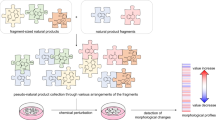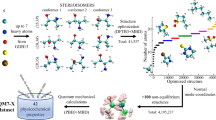Abstract
Small-molecule, biologically active natural products continue to be our most rewarding source of, and inspiration for, new medicines1. Sometimes we happen upon such molecules in minute quantities in unique, difficult-to-reach, and often fleeting environments, perhaps never to be discovered again. In these cases, determining the structure of a molecule—including assigning its relative and absolute configurations—is paramount, enabling one to understand its biological activity. Molecules that comprise stereochemically complex acyclic and conformationally flexible carbon chains make such a task extremely challenging2. The baulamycins (A and B) serve as a contemporary example. Isolated in small quantities and shown to have promising antimicrobial activity, the structure of the conformationally flexible molecules was determined largely through J-based configurational analysis3,4, but has been found to be incorrect. Our subsequent campaign to identify the true structures of the baulamycins has revealed a powerful method for the rapid structural elucidation of such molecules. Specifically, the prediction of nuclear magnetic resonance (NMR) parameters through density functional theory—combined with an efficient sequence of boron-based synthetic transformations, which allowed an encoded (labelled) mixture of natural-product diastereomers to be prepared—enabled us rapidly to pinpoint and synthesize the correct structures.
This is a preview of subscription content, access via your institution
Access options
Access Nature and 54 other Nature Portfolio journals
Get Nature+, our best-value online-access subscription
$29.99 / 30 days
cancel any time
Subscribe to this journal
Receive 51 print issues and online access
$199.00 per year
only $3.90 per issue
Buy this article
- Purchase on SpringerLink
- Instant access to full article PDF
Prices may be subject to local taxes which are calculated during checkout




Similar content being viewed by others
References
Newman, D. J. & Cragg, G. M. Natural products as sources of new drugs from 1981 to 2014. J. Nat. Prod. 79, 629–661 (2016)
Nicolaou, K. C. & Snyder, S. A. Chasing molecules that were never there: misassigned natural products and the role of chemical synthesis in modern structure elucidation. Angew. Chem. Int. Edn 44, 1012–1044 (2005)
Matsumori, N., Kaneno, D., Murata, M., Nakamura, H. & Tachibana, K. Stereochemical determination of acyclic structures based on carbon−proton spin-coupling constants. A method of configuration analysis for natural products. J. Org. Chem. 64, 866–876 (1999)
Tripathi, A . et al. Baulamycins A and B, broad-spectrum antibiotics identified as inhibitors of siderophore biosynthesis in Staphylococcus aureus and Bacillus anthracis. J. Am. Chem. Soc. 136, 1579–1586 (2014); erratum 136, 10541–10541 (2014)
O’Neill, J. Review on Antimicrobial Resistance: Tackling a Crisis for the Health and Wealth of Nations (Wellcome Trust/HM Government, 2014)
WHO. Antimicrobial Resistance: Global Report on Surveillance (WHO, Geneva, 2014)
Fischbach, M. A. & Walsh, C. T. Antibiotics for emerging pathogens. Science 325, 1089–1093 (2009)
Quadri, L. E. N. Strategic paradigm shifts in the antimicrobial drug discovery process of the 21st century. Infect. Disord. Drug Targets 7, 230–237 (2007)
Guchhait, S., Chatterjee, S., Ampapathi, R. S. & Goswami, R. K. Total synthesis of reported structure of baulamycin A and its congeners. J. Org. Chem. 82, 2414–2435 (2017)
Willoughby, P. H., Jansma, M. J. & Hoye, T. R. A guide to small-molecule structure assignment through computation of (1H and 13C) NMR chemical shifts. Nat. Protocols 9, 643–660 (2014)
Smith, S. G. & Goodman, J. M. Assigning stereochemistry to single diastereoisomers by GIAO NMR calculation: the DP4 probability. J. Am. Chem. Soc. 132, 12946–12959 (2010)
Lodewyk, M. W., Siebert, M. R. & Tantillo, D. J. Computational prediction of 1H and 13C chemical shifts: a useful tool for natural product, mechanistic, and synthetic organic chemistry. Chem. Rev. 112, 1839–1862 (2012)
Burns, M. et al. Assembly-line synthesis of organic molecules with tailored shapes. Nature 513, 183–188 (2014)
Fawcett, A. et al. Regio- and stereoselective homologation of 1,2-bis(boronic esters): stereocontrolled synthesis of 1,3-diols and Sch 725674. Angew. Chem. Int. Edn 55, 14663–14667 (2016)
Blaisdell, T. P., Caya, T. C., Zhang, L., Sanz-Marco, A. & Morken, J. P. Hydroxyl-directed stereoselective diboration of alkenes. J. Am. Chem. Soc. 136, 9264–9267 (2014)
Jain, P. & Antilla, J. C. Chiral Brønsted acid-catalyzed allylboration of aldehydes. J. Am. Chem. Soc. 132, 11884–11886 (2010)
Grayson, M. N., Pellegrinet, S. C. & Goodman, J. M. Mechanistic insights into the BINOL-derived phosphoric acid-catalyzed asymmetric allylboration of aldehydes. J. Am. Chem. Soc. 134, 2716–2722 (2012)
Ohmura, T., Yamamoto, Y. & Miyaura, N. Rhodium- or iridium-catalyzed trans-hydroboration of terminal alkynes, giving (Z)-1-alkenylboron compounds. J. Am. Chem. Soc. 122, 4990–4991 (2000)
Sadhu, K. M. & Matteson, D. S. (Chloromethyl)lithium: efficient generation and capture by boronic esters and a simple preparation of diisopropyl (chloromethyl)boronate. Organometallics 4, 1687–1689 (1985)
Molander, G. A., Yun, C. S., Ribagorda, M. & Biolatto, B. B-alkyl Suzuki–Miyaura cross-coupling reactions with air-stable potassium alkyltrifluoroborates. J. Org. Chem. 68, 5534–5539 (2003)
Pereira, S. & Srebnik, M. Transition metal-catalyzed hydroboration of and CCl4 addition to alkenes. J. Am. Chem. Soc. 118, 909–910 (1996)
Zweifel, G., Arzoumanian, H. & Whitney, C. C. A convenient stereoselective synthesis of substituted alkenes via hydroboration-iodination of alkynes. J. Am. Chem. Soc. 89, 3652–3653 (1967)
Tamao, K., Nakagawa, Y. & Ito, Y. Regio- and stereoselective intramolecular hydrosilylation of α-hydroxy enol esters: 2,3-syn-2-methoxy-methoxy-1,3-nonanediol. Org. Synth. 73, 94 (1996)
Rohr, K., Herre, R. & Mahrwald, R. Toward asymmetric aldol-tishchenko reactions with enolizable aldehydes: access to defined configured stereotriads, tetrads, and stereopentads. J. Org. Chem. 74, 3744–3749 (2009)
Sellars, J. D. & Steel, P. G. Application of silacyclic allylsilanes to the synthesis of β-hydroxy-d-lactones: synthesis of prelactone B. Tetrahedron 65, 5588–5595 (2009)
Ruiz, J., Karre, N., Roisnel, T., Chandrasekhar, S. & Grée, R. From protected β-hydroxy acylsilanes to functionalized silyl enol ethers and applications in Mukaiyama aldol reactions. Eur. J. Org. Chem. 773–779 (2016)
Jones, C. R. et al. Subtle temperature-induced changes in small molecule conformer dynamics—observed and quantified by NOE spectroscopy. Chem. Commun. (Camb.) 52, 2920–2923 (2016)
Dutheuil, G., Selander, N., Szabó, K. J. & Aggarwal, V. K. Direct synthesis of functionalized allylic boronic esters from allylic alcohols and inexpensive reagents and catalysts. Synthesis 14, 2293–2297 (2008)
Curran, D. P., Sinha, M. K., Zhang, K., Sabatini, J. J. & Cho, D.-H. Binary fluorous tagging enables the synthesis and separation of a 16-stereoisomer library of macrosphelides. Nat. Chem. 4, 124–129 (2012)
Acknowledgements
We thank the UK Engineering and Physical Sciences Research Council (EPSRC; grant EP/I038071/1) and the European Research Council (ERC; funding programme FP7; grant 670668) for financial support; and the UK Biotechnology and Biological Sciences Research Council (BBSRC)/EPSRC-funded BrisSynBio Research Centre (L01386X) for providing the 700 MHz NMR spectrometer used. Parts of this work were carried out using the computational facilities of the Advanced Computing Research Centre at the University of Bristol (http://www.bris.ac.uk/acrc/). P.L. thanks Xunta de Galicia, M.A. thanks HEC Pakistan, and J.W. thanks the Shanghai Institute of Organic Chemistry for postdoctoral fellowships. S.Z. thanks the EPSRC Bristol Chemical Synthesis Doctoral Training Centre for a studentship (EP/L015366/1). We thank D. Sherman for providing the raw NMR (free induction decay) data for baulamycin A.
Author information
Authors and Affiliations
Contributions
V.K.A., E.L.M. and C.P.B. designed and led the project. P.L., J.W. and M.A. designed and conducted the synthesis experiments and analysed the data. S.Z. performed computational and NMR studies and analysed the data. All authors contributed to the writing of the manuscript.
Corresponding authors
Ethics declarations
Competing interests
The authors declare no competing financial interests.
Additional information
Reviewer Information Nature thanks K.J. Szabó and the other anonymous reviewer(s) for their contribution to the peer review of this work.
Publisher's note: Springer Nature remains neutral with regard to jurisdictional claims in published maps and institutional affiliations.
Supplementary information
Supplementary Information
This file contains Supplementary Text and Data – see contents page for details.
Rights and permissions
About this article
Cite this article
Wu, J., Lorenzo, P., Zhong, S. et al. Synergy of synthesis, computation and NMR reveals correct baulamycin structures. Nature 547, 436–440 (2017). https://doi.org/10.1038/nature23265
Received:
Accepted:
Published:
Issue Date:
DOI: https://doi.org/10.1038/nature23265



